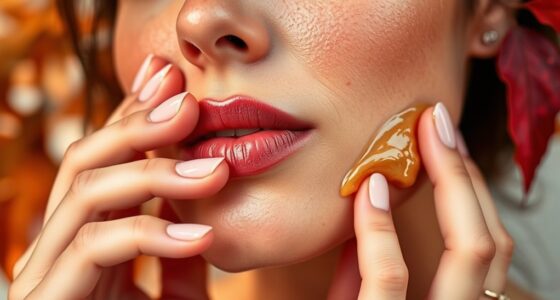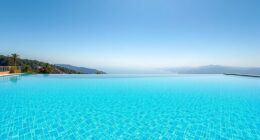To care for your skin seasonally as a tanner, you should adapt your routine to combat environmental changes. In summer, protect your skin with SPF and rehydrate frequently, while exfoliating gently to maintain an even tan. In winter, focus on deep moisturization, gentle exfoliation, and limiting harsh products. Spring and fall call for balanced hydration and exfoliation to prepare your skin for the upcoming season. Keep your skincare routine adaptable, and you’ll enjoy a smooth, healthy glow year-round. Continue to discover how tailored practices can maximize your tan’s longevity and health.
Key Takeaways
- Adjust skincare routines seasonally to combat environmental stress, focusing on hydration, exfoliation, and protection for optimal tanning results.
- Use broad-spectrum SPF daily and reapply outdoors, especially during peak summer UV hours, to prevent sun damage and maintain an even tan.
- Incorporate season-specific moisturizers—rich and hydrating in winter, lightweight and soothing in summer—to support skin health and tan longevity.
- Exfoliate gently 1-2 times weekly, targeting rough areas, to promote smooth skin and even color development across seasons.
- Choose tanning products and serums that match seasonal needs, such as richer formulas in colder months and lightweight options in warmer weather.
Understanding the Impact of Seasons on Skin Health
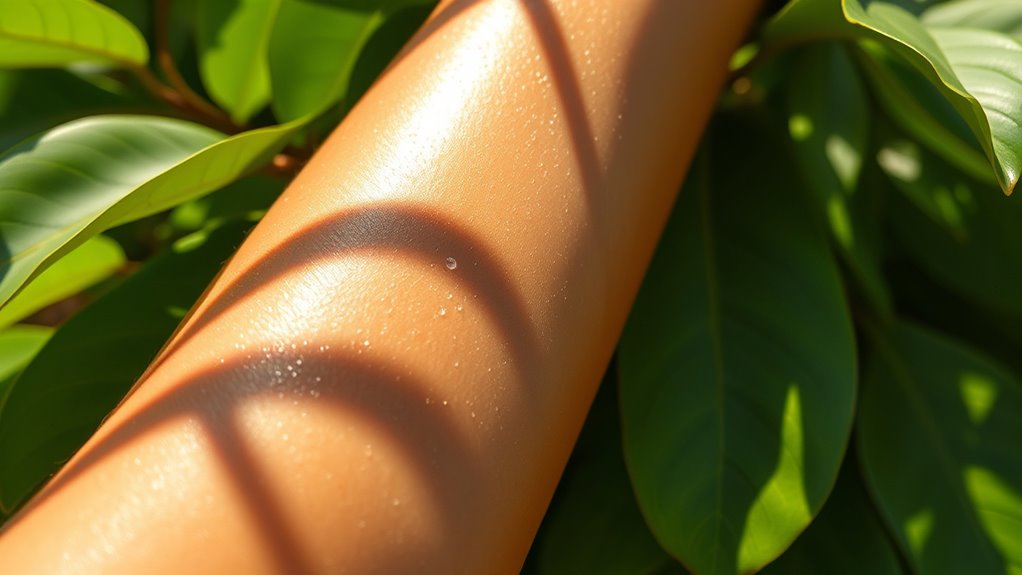
Seasons particularly influence your skin’s health and how it responds to tanning. During summer, high temperatures and humidity boost oil production, which can enhance tanning but also increase sunburn risk. In fall, cooler weather dries out your skin, leaving it flaky and uneven, affecting your tan’s appearance. Winter’s cold air and indoor heating strip moisture from your skin, making it harder to maintain a natural glow. Spring helps your skin recover moisture, setting the stage for better tanning results. Additionally, seasonal variations in humidity levels can impact skin hydration and tanning outcomes throughout the year. These fluctuations also influence the skin’s natural barrier, affecting how your skin retains moisture and reacts to environmental stressors. Understanding how each season impacts your skin and environmental factors guides you in choosing the right products and protective measures, ensuring your skin stays healthy while achieving your desired tan. Recognizing seasonal skin changes can help you better tailor your skincare routine for optimal results.
Essential Year-Round Skincare Practices for Tanners
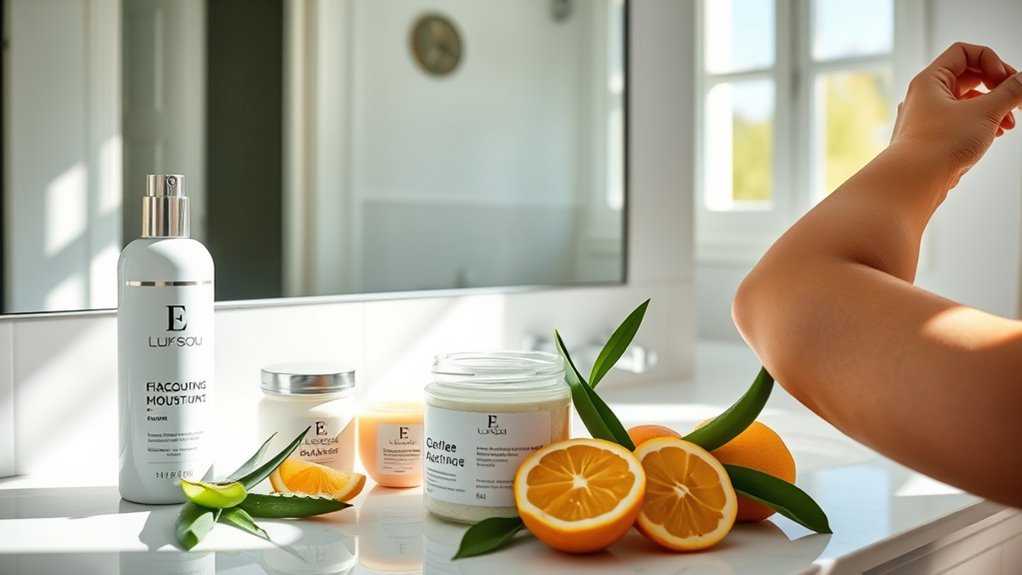
Maintaining healthy, vibrant skin while tanning year-round requires consistent skincare practices that adapt to your skin’s changing needs. Hydration is key—drink plenty of water and use moisturizers with emollients like hyaluronic acid to keep skin supple and prevent dryness or flakiness. Focus on applying moisturizer daily, especially on areas prone to dryness, to avoid peeling and uneven fading. Use lightweight, hydrating formulas instead of heavy oils that can interfere with tanning products’ absorption. Protect your skin by applying broad-spectrum sunscreen with SPF 30 or higher, even when using self-tanners, and reapply every two hours outdoors. Incorporate gentle exfoliation 1-2 times weekly to remove dead skin cells, promoting a smooth surface for even tanning. Consistent moisturizing and sun protection are essential for maintaining a radiant, long-lasting tan year-round. Additionally, understanding Angel Numbers can help you recognize the signs of your skin’s needs and the right timing for skin treatments. Staying mindful of skin health indicators can further optimize your skincare routine and ensure your skin remains glowing and well-protected.
Adapting Your Routine for Winter Skin Challenges
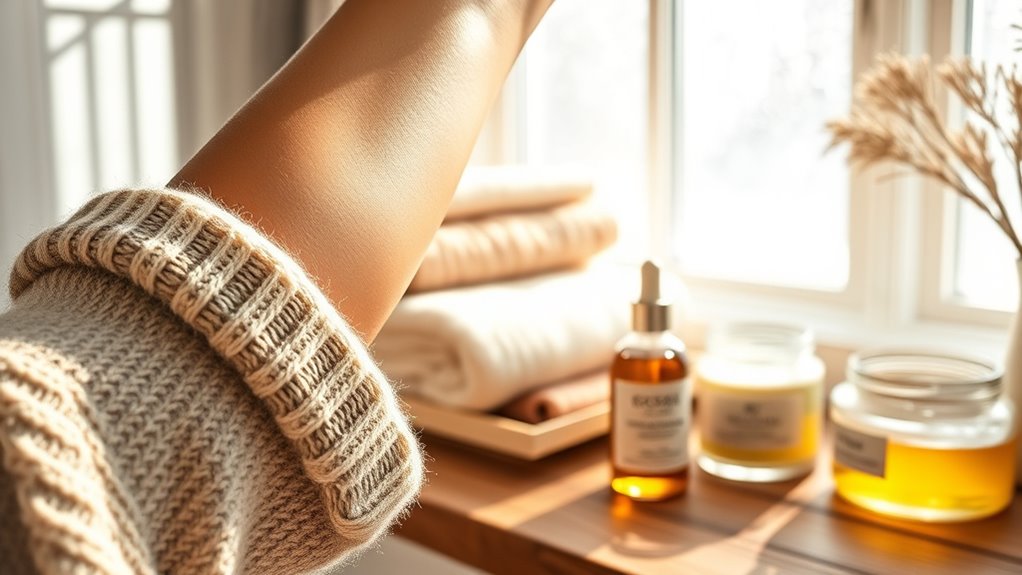
As winter brings dry air and indoor heating that strip moisture from your skin, adapting your skincare routine becomes necessary to keep your tan looking even and vibrant. Start by using gentle exfoliants to remove dead skin cells, especially on rough areas like elbows and knees. Follow with rich, hydrating moisturizers that lock in moisture and prevent dryness, which can cause uneven tans. Drink plenty of water to support internal hydration and help maintain skin elasticity. Avoid harsh products and opt for lightweight, oil-free lotions that won’t interfere with your self-tanner. Protect your skin from environmental stressors by wearing protective clothing and using sunscreen. Incorporating low light office plants into your space can help improve indoor air quality and create a more soothing environment for your skin’s health. Regularly applying humidification techniques can greatly enhance your skin’s resilience and appearance during colder months. Consistent moisturization and gentle exfoliation will ensure your tan stays smooth, even, and radiant throughout the winter months.
Summer Skincare Strategies to Protect and Enhance Your Tan

To protect and enhance your tan during summer, prioritize daily application of broad-spectrum SPF 30+ sunscreen, ensuring your skin stays shielded from harmful UV rays. Apply it 15-30 minutes before sun exposure and reapply every two hours or after swimming or sweating. Choose water-resistant, lightweight formulas for comfort and protection. Seek shade during peak hours (10 AM to 4 PM) to minimize damage and prevent premature fading. Incorporate physical blockers like zinc oxide or titanium dioxide if you have sensitive skin to avoid irritation. Keep your skin hydrated with lightweight, non-comedogenic moisturizers containing soothing ingredients like jojoba oil and shea butter. Drink plenty of water, and use after-sun products with aloe vera or antioxidants to calm and repair sun-exposed skin. Support your skin’s resilience by choosing products with antioxidants and nourishing oils, which are beneficial for skin health and repair. Additionally, applying UV protection methods consistently helps maintain your tan and reduces long-term skin damage. Using an air purifier in your indoor environment can also improve air quality, reducing pollutants and allergens that may irritate sensitive or sun-exposed skin. Incorporating natural essential oils known for their skin-healing properties, such as lavender or tea tree, can further enhance your skin’s recovery process.
Incorporating Specialized Products for Optimal Skin and Tan Care
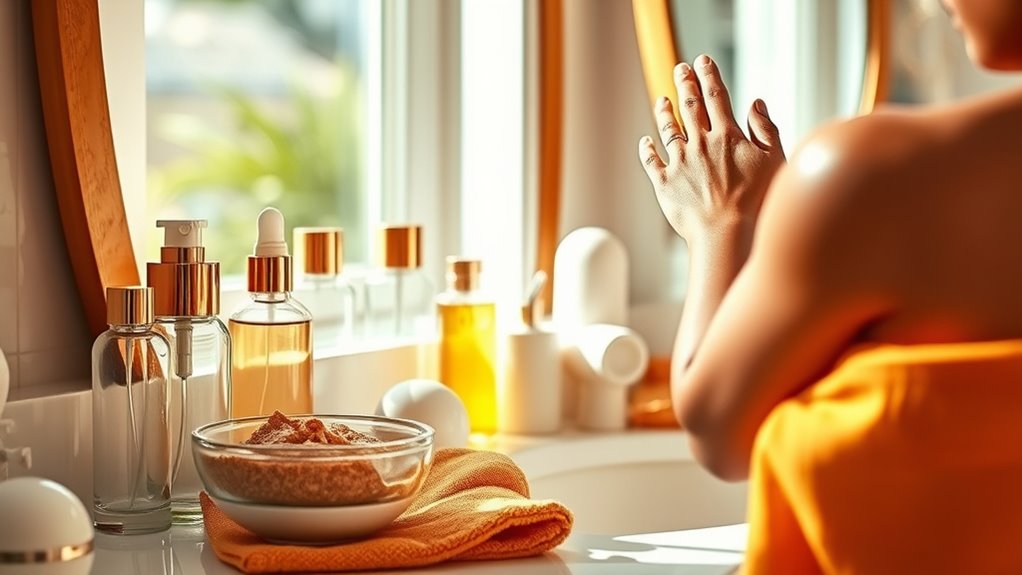
Incorporating specialized skincare products can considerably enhance your skin’s health and help you achieve a radiant, even tan. Using serums with ingredients like Vitamin C brightens your skin and reduces hyperpigmentation, ensuring your tan looks smooth and consistent. Retinol-based products repair UV damage and improve skin texture, essential after sun exposure. Peptide serums boost elasticity and firmness, helping prevent signs of aging, while niacinamide serums even out skin tone and reduce inflammation. Kojic acid serums help diminish dark spots and hyperpigmentation, promoting a uniform complexion. Protecting your skin with broad-spectrum sunscreens or SPF-infused tanning oils shields against UV damage and maintains hydration. Seasonal skincare bundles and targeted serums allow you to customize your routine, ensuring your skin stays healthy, hydrated, and beautifully tan year-round. Additionally, incorporating sulfate-free shampoos can help maintain your skin’s moisture barrier and overall health during the tanning season. Using specialized products like eye patches can further support your skincare routine by reducing puffiness and refreshing tired eyes, especially during the busy tanning months. Incorporating skincare routines that include antioxidant-rich products can provide additional protection against environmental stressors that may accelerate skin aging.
Choosing the Right Self-Tanners and Tanning Kits for Each Season

Choosing the right self-tanner or tanning kit depends on your seasonal needs and skin tone. In warmer months like spring and summer, opt for lightweight mousses that give a natural, streak-free glow, perfect for a subtle, sun-kissed look. During fall and winter, deeper tanning lotions or overnight formulas work better, providing longer-lasting, richer tones suitable for paler skin. Customizable tanning drops let you adjust color intensity for any season, offering versatility. Kits with both facial and body tanners help ensure a consistent color throughout the year. Seasonal bundles often include additional products like scrubs or mitts, optimizing application and maintaining your tan’s appearance regardless of humidity or dryness. Select formulas and tools that match your skin’s needs and seasonal environment for the best results.
The Role of Exfoliation and Hydration in Maintaining a Flawless Tan
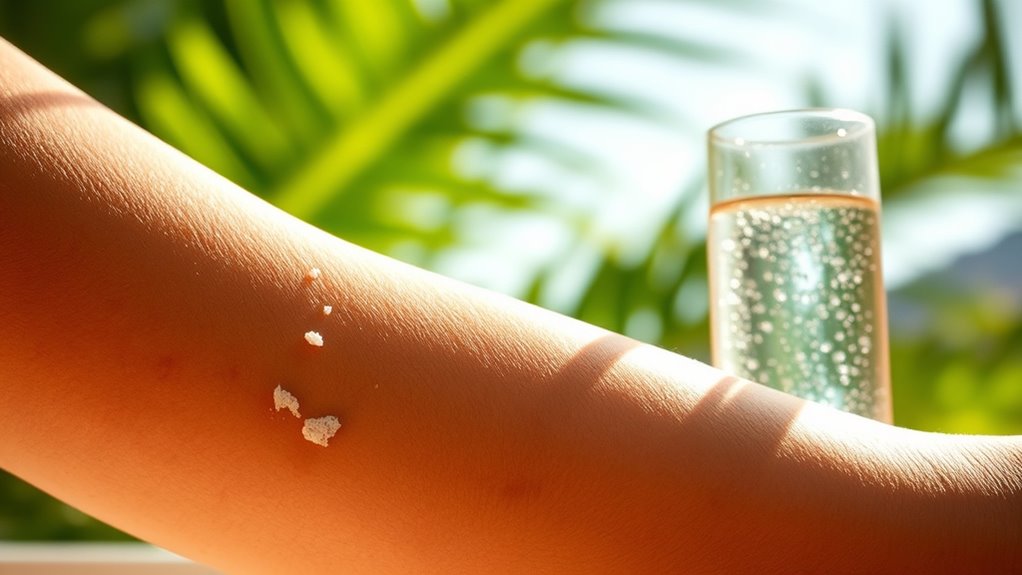
Exfoliation and hydration are essential steps in maintaining a flawless tan because they directly influence how evenly and long-lasting your skin’s color appears. Exfoliating removes dead skin cells, promoting an even tan and better application of sunscreen or tanning solutions. It also encourages cell regeneration, helping your tan last longer. Focus on rough areas like elbows and knees for ideal results. Hydration keeps your skin plump and prevents rapid fading, maintaining a natural glow. Moisturizers with ingredients like argan oil or cucumber extract enhance tanning longevity and soothe your skin. Regular hydration supports skin elasticity and reduces dryness or patches that could cause uneven absorption. Additionally, choosing high-quality skincare products can further improve your skin’s response to tanning. Incorporating proper exfoliation techniques ensures the removal of dead cells without damaging the skin, thereby supporting a smoother tanning process. Maintaining skin health through proper nutrition and protection from environmental damage also plays a vital role in achieving a flawless, long-lasting tan. Understanding skin health is crucial for customizing your skincare routine to seasonal changes, ensuring your skin remains smooth, healthy, and perfectly prepared for a flawless, lasting tan.
Tips for Post-Sun and Post-Application Skin Care

After you’ve applied a tan or spent time in the sun, caring for your skin helps preserve your glow and prevent irritation. Start by moisturizing with soothing ingredients like aloe vera, shea butter, or hyaluronic acid to replenish lost moisture and lock in hydration. Use cool compresses or aloe vera gel to calm heated or irritated skin. Avoid products with alcohol or fragrances, which can cause further irritation. Gently cleanse your skin with mild, fragrance-free cleansers to preserve natural oils. Protect your skin daily with broad-spectrum sunscreen, even after tanning, and wear protective clothing to prevent overexposure. Limit sun exposure and avoid heavy makeup that can clog pores. Proper post-sun skin care not only soothes and hydrates but also extends your tan’s vibrancy.
Creating a Customized Seasonal Tanning and Skincare Routine
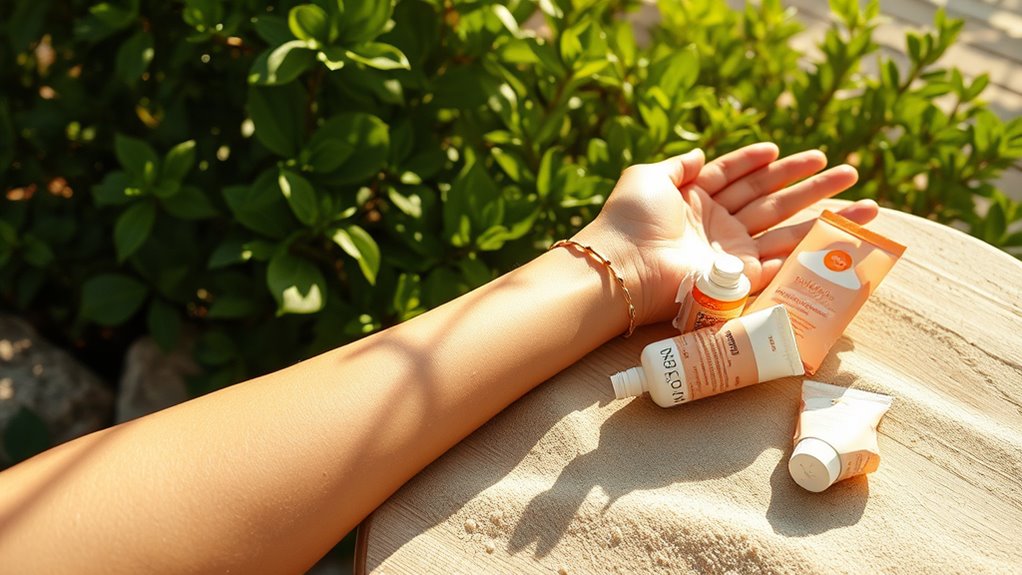
Creating a customized seasonal tanning and skincare routine involves tailoring your products and practices to match the changing environmental conditions and your skin’s needs throughout the year. In winter, use rich moisturizers with shea butter, hyaluronic acid, or glycerin to combat dryness from cold weather and indoor heating. Incorporate gentle exfoliation to smooth your skin and prepare it for even tanning. During spring, switch to lighter formulas with melanin accelerators, boosting natural color as temperatures rise. In summer, protect your skin with broad-spectrum SPF to prevent burns while maintaining a golden glow, and stay hydrated to counteract sweat and heat. In fall, focus on hydration and gentle exfoliation to prevent flakiness and sustain your tan. Adjust your tanning frequency and product choices based on UV exposure and humidity levels for suitable results year-round.
Frequently Asked Questions
How Can I Prevent Dry Skin During Seasonal Transitions?
To prevent dry skin during seasonal shifts, you should start hydrating early with rich moisturizers containing hyaluronic acid, ceramides, and shea butter. Switch to heavier creams in colder months, take shorter, warm showers, and use gentle cleansers. Adding a humidifier indoors and protecting your skin from harsh weather also helps. Remember to apply broad-spectrum sunscreen year-round to shield your skin from UV rays and prevent further dryness.
What Ingredients Should I Look for in Winter Moisturizers?
Think of your skin as a fortress that needs sturdy bricks to stand strong. In winter, look for moisturizers with hydrating agents like hyaluronic acid and glycerin to lock in moisture. Nourishing oils such as coconut and shea butter rebuild your barrier, while antioxidants like green tea and vitamin E fight off environmental stress. These ingredients work together to keep your skin resilient, soft, and glowing despite harsh winter conditions.
How Does Humidity Affect Self-Tanner Application and Longevity?
Humidity can make self-tanner application tricky because it increases skin moisture, causing stickiness and uneven color. It also slows down drying, risking smudges and streaks. Sweat from high humidity shortens your tan’s lifespan by washing away or breaking down the tanner faster. To improve results, apply during low-humidity times, use fast-drying formulas, and keep skin moisturized. Storing your tanner in a cool, dry place also helps maintain its effectiveness.
Are There Specific Sunscreens Recommended for Tanned Skin?
You should look for sunscreens designed for tanned skin, like tinted mineral options with SPF 30-50 that match your tone and prevent white cast. Water-resistant formulas, such as sprays or lotions with SPF 30-70, are great for outdoor activities. Choose lightweight textures like gels or dry-touch lotions for comfort. Incorporate products with hydrating ingredients and avoid irritation, ensuring your skin stays protected and looks great after tanning.
How Often Should I Exfoliate for Optimal Tanning Results?
Imagine your skin as a canvas ready for a beautiful painting. To keep that tan glowing smoothly, you should exfoliate 2-3 times a week, gently sloughing off dead skin like clearing away old brushstrokes. Do it once a week before applying self-tanner for a flawless finish. Just don’t overdo it—more than three times can irritate your skin, dulling your tan’s brilliance and making your skin look tired.
Conclusion
Now that you know how each season affects your skin and tan, are you ready to discover the secret to flawless, radiant skin year-round? With the right routines and products, you’ll not only protect your glow but also elevate it to new heights. But remember, the true transformation begins when you master these seasonal secrets—something extraordinary is just around the corner. Stay tuned, because your perfect tan isn’t just a goal—it’s within your reach.




